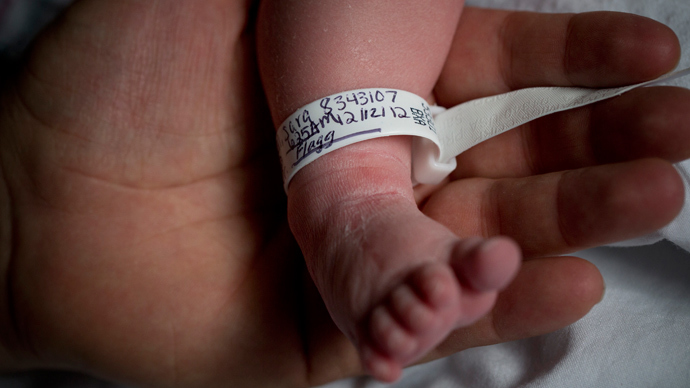‘First time' in history: White deaths outnumber births in US
Published time: June 13, 2013 10:51
Edited time: June 13, 2013 12:11 
Reuters / Andrew Kelly
Deaths of white people outnumbered births for the very first time in US history, the Census Bureau revealed Thursday. The census predicts that significant drops in birth rates v death rates will be regular by 2025.
The new 2012 annual census calculated births minus deaths as of July 2012 and saw a decrease of about 12,400 people out of 198 million non-Hispanic whites in the country.
Several demographers have pointed out that no other racial group in the US experienced a similar drop.
Such a natural decrease within the white population is the first of its kind and was not even observed in the US during wars or Depression, the Washington Post reported.
Non-Hispanic whites in the US are older than other groups, with a median age of 42. In comparison, the median age for Asians is 34, for African Americans, it is under 32, and for Hispanics it is under 28.
“We’re jumping the gun on a long, slow decline of our white population, which is going to characterize this century,” demographer with the Brookings Institution William Frey, who analyzed the census data, told the Washington Post.

Kids celebrate being at the 2013 NBA Finals Legacy Project as part of the 2013 NBA Finals on June 7, 2013 at the Joe Celestin Center in Miami, Florida (NBAE Nathaniel S. Butler / NBAE via Getty Images / AFP)
The data also revealed that half of the America’s under-5 age group is made up of racial and ethnic minorities, amounting to 49.9 percent in 2012.
If the current rate of growth continues, then the whites in the under-5 group will become a minority in 2013-14, the Census Bureau's acting director Thomas Mesenbourg told AP.
The Bureau also predicts that just in five years minorities will become the majority of children under 18.
And after that mark the total white population will start to significantly decline as aging baby boomers will start dying.

John Moore / Getty Images / AFP
Demographic and economic factors behind drop in birth rates
The decline in births rates for the past several years include demographic and economic factors.
One reason is women with college degrees are choosing careers and are postponing getting married and having kids till at least late into their 20s. And census shows that if women have children later in life they will opt to have fewer of them, or be unable to have more.
Also, data revealed that white women are more likely to be childless than Hispanic or African American women.
The economic recession that hit the US in 2007 also had a negative impact on birth rates, as more white women believed that they could not afford to have more kids.

Reuters / Rick Wilking
The 2012 fall in white births versus deaths ratio is not the first alarming number that was released to the public this past couple of years.
The 2011 census, published in May 2012, showed that for the first time in US history white births make up fewer than half the children born in the country, according to the US Census Bureau. Non-Hispanic whites accounted for 49.6 per cent of all births in the 12-month period in 2011 that ended last July.
A drop in the non-Hispanic white population came a decade earlier than the Census Bureau predicted initially. Demographers cited two factors as reasons for the earlier drop: decreasing birth rate and slower immigration levels. Birth rate and immigration usually balance out a population decrease.
Moreover, the inflow of 188,000 white immigrants into the US in 2012 played a role at keeping non-Hispanic whites at 63 percent of the country’s population – the largest single group in the US.
Demographer Ken Johnson believes there is hope yet.
“Once this recession has waned, we’re probably going to see at least a temporary uptick in births until death rates start to rise,” he said.

Head Coach Gregg Popovich of the San Antonio Spurs interacts with the kids at the 2013 NBA Cares Legacy Project as part of the 2013 NBA Finals on June 7, 2013 at the Wheatley Middle School in San Antonio, Texas (NBAE Nathaniel S. Butler / NBAE via Getty Images / AFP)
But Frey believes that the older white population will start depending more on the younger population (which is a minority).
“More so than ever, we need to recognize the importance of young minorities for the growth and vitality of our labor force and economy,'' Frey added. “Last year, we saw the majority of babies are minorities. Now we see more whites are dying than being born. Together, that tells us a lot about where we’re going as a country.”
Ethnic changes in the US are prompting activists to demand for amends to some of the civil rights programs in higher education, such as affirmative action in college admissions.
The Supreme Court is expected to rule on the issue this month. Activists are arguing that they should now be more focused on income rather than race and ethnicity, AP reported.
Currently there are more than 36 percent of university students that are minorities, up from 16 percent in 1980. And the black voter turnout was more than white turnout in last year's presidential election.
http://rt.com/usa/us-white-births-census-613/